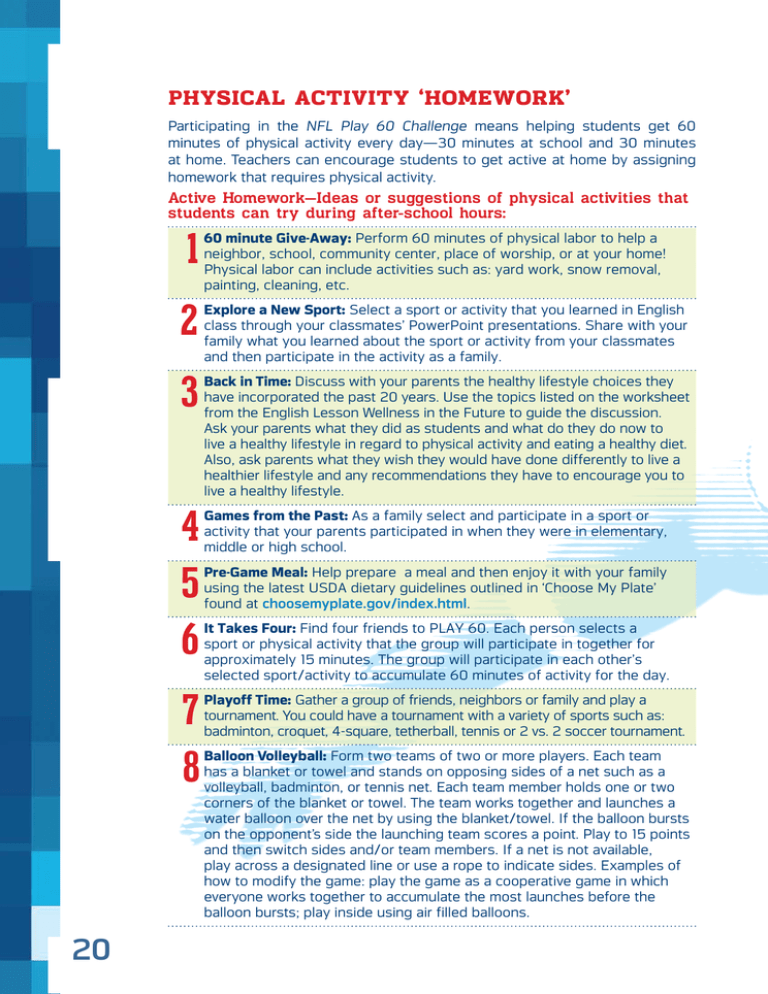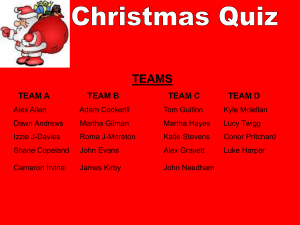physIcal actIvIty `homeWork`
advertisement

Physical Activity ‘Homework’ Participating in the NFL Play 60 Challenge means helping students get 60 minutes of physical activity every day—30 minutes at school and 30 minutes at home. Teachers can encourage students to get active at home by assigning homework that requires physical activity. Active Homework—Ideas or suggestions of physical activities that students can try during after-school hours: 1 20 60 minute Give-Away: Perform 60 minutes of physical labor to help a neighbor, school, community center, place of worship, or at your home! Physical labor can include activities such as: yard work, snow removal, painting, cleaning, etc. 2 Explore a New Sport: Select a sport or activity that you learned in English class through your classmates’ PowerPoint presentations. Share with your family what you learned about the sport or activity from your classmates and then participate in the activity as a family. 3 Back in Time: Discuss with your parents the healthy lifestyle choices they have incorporated the past 20 years. Use the topics listed on the worksheet from the English Lesson Wellness in the Future to guide the discussion. Ask your parents what they did as students and what do they do now to live a healthy lifestyle in regard to physical activity and eating a healthy diet. Also, ask parents what they wish they would have done differently to live a healthier lifestyle and any recommendations they have to encourage you to live a healthy lifestyle. 4 5 6 Games from the Past: As a family select and participate in a sport or activity that your parents participated in when they were in elementary, middle or high school. 7 8 Playoff Time: Gather a group of friends, neighbors or family and play a tournament. You could have a tournament with a variety of sports such as: badminton, croquet, 4-square, tetherball, tennis or 2 vs. 2 soccer tournament. Pre-Game Meal: Help prepare a meal and then enjoy it with your family using the latest USDA dietary guidelines outlined in ‘Choose My Plate’ found at choosemyplate.gov/index.html. It Takes Four: Find four friends to PLAY 60. Each person selects a sport or physical activity that the group will participate in together for approximately 15 minutes. The group will participate in each other’s selected sport/activity to accumulate 60 minutes of activity for the day. Balloon Volleyball: Form two teams of two or more players. Each team has a blanket or towel and stands on opposing sides of a net such as a volleyball, badminton, or tennis net. Each team member holds one or two corners of the blanket or towel. The team works together and launches a water balloon over the net by using the blanket/towel. If the balloon bursts on the opponent’s side the launching team scores a point. Play to 15 points and then switch sides and/or team members. If a net is not available, play across a designated line or use a rope to indicate sides. Examples of how to modify the game: play the game as a cooperative game in which everyone works together to accumulate the most launches before the balloon bursts; play inside using air filled balloons. 9 10 11 12 13 14 Bookends. Have students do 50 jumping jacks before they start their homework, do 15 crunches between subjects, and when they have finished all their homework, end with the “pretend jump rope” exercise, counting 50 revolutions. Push-up Challenge: Watch an NFL or college football game on TV. Every time your team scores, do push-ups to equal your team’s total score. For an additional challenge, also do push-ups when the other team scores. Tackle Obesity: Create a 10 minute physical activity routine that you and your parents can do two to three nights a week. Compare your routine with your classmates. Jump your Way to Better Health: Perform a variety of jumping activities to help develop muscle and bone strength: 20 jumping Jacks, 20 goal post jumps (vertically jump in the air), 20 standing long jumps (jump forward), jump rope 20 times. Training Table: Eat three to five different colors of fruits and/or vegetables in one day. Which did you like the best? Why? Punt, Pass, Kick: Measure the distance you can punt, pass and kick a football. Add the three distances together for a total combined score. Do this 5 times and then calculate the average of your total combined score. Participate in official NFL youth football events. Find out more about this program, which is celebrating it’s 50th anniversary, at NFLRUSH.com. 15 TV Challenge. If students are watching TV at night, provide a ‘workout routine’ conducive to commercial breaks (i.e. short 2-3 minute circuits such as push-ups, crunches, squats, etc). Have the class brainstorm to come up with a new circuit for every week and write it down in their Student Game Planners. Here are some ideas: • Hop on one foot for 30 seconds, switch and hop on the other foot for 30 seconds • Walk up and down the hall or around the room on your tip toes for one minute • Wall sit: Stand against a wall, slowly bend your knees down into a 90 degree angle, keeping back against the wall. Hold for 30-60 seconds • Stand with feet shoulder width apart, bend one knee up into a 90 degree angle, balancing on the other leg. Hold for a count of 20 and switch legs. Do five repetitions • Lay on your back and write your first name in the air with your toe. Switch legs and write your last name • Three sets of push ups — 15 each set • Lay on your back, extend both legs into the air at a 90 degree angle from the floor. Slowly lower your legs (knees straight) to the floor. Repeat for 20 repetitions • Jump tucks: Stand with feet shoulder-width apart, knees slightly bent, with arms at sides. Jump up bringing knees up to chest, land on balls of feet. Do 10 repetitions 16 Physical Activity—Read all about it!: Students will interview a parent or guardian about their physical activity habits using the interview questions from English class. 21 Physical Activity ‘Homework’ continued 17 What Happens When You Move? Teach your family how to take their heart rate. Measure resting heart rate by finding radial pulse (at the wrist) or carotid pulse (at the neck). Count the number of beats in 10 seconds. Multiply that number by six to calculate the average number of heart beats per minute. Tell your family that you will be going on a 20 minute walk. Have everyone take their heart rate four times: 1) before going on the 20 minute walk 2) after walking for 10 minutes 3) right after completing the 20 minute walk 4) 10 minutes after you finish the walk. Have everyone share what their heart rate was for the four different times and discuss what happened to your heart rate and why. Take your heart rate during other physical activities such as jogging, biking or swimming. 18 Verbs in Motion: Read a sports article in the newspaper about a high school, college or professional game. Underline the action verbs in the article and perform the actions. For example, if you read an article about a football game you might underline action verbs such as pass, throw and kick. Grab a football and go outside and practice passing, throwing and kicking the ball. 19 20 21 22 Rev-up Reading: When you assign reading homework, also provide students with some activities to help improve concentration, such as stretches before beginning and a break every 20 minutes 23 Joint Efforts: Assign students a list of activities and have them perform the activities and identify what type of movable joint in the human skeleton is utilized — ball and socket, hinge, or gliding (swing a bat, throw a football, jumping jacks, push-ups, wave goodbye, hop on one foot, etc). 24 25 Support a Cause: Have students sign up for a 5K race for a cause in your community and run or walk as a class (students can also walk with their families). Go Green: Helping the environment is healthy for you too. Have students pick up trash in their neighborhood or around the school grounds as part of an eco-awareness lesson. Make sure they wear gloves! Sports Count: Encourage students to participate in a sporting event and calculate the statistics of the game as a math activity (football, soccer, tennis, etc). Water Works: Staying hydrated can help you perform at your peak and prevent unpleasant problems like cramping and early fatigue. Have students work on getting eight cups of water every day for a week and notice if they’re performing better. Have them track their water intake in their Student Game Planners. How Successful are You? Play catch or shoot baskets with family or friends and calculate your percent of success. For example, if you make 8 out of 10 basketball shots, you are 80% successful. Log-On: Check out fun games and additional opportunities and idea for living a physically active life by logging on the NFL PLAY 60 website: NFLRUSH.com/play60 22

